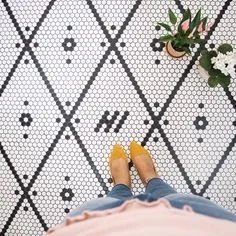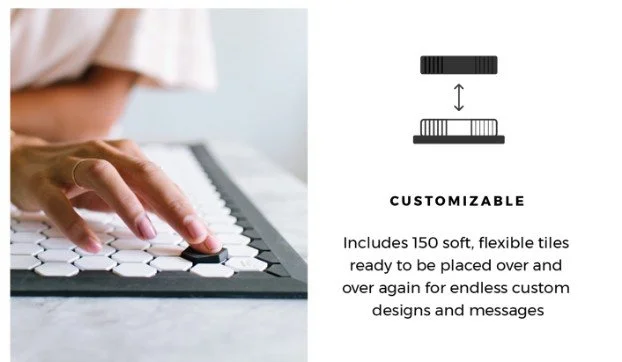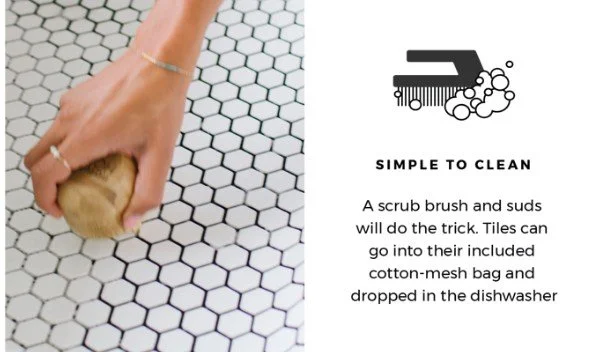Tile Mat
Inspiration
Inspired by messaging embedded in mosaic hex tiles, often seen in trendy commercial spaces, Johnny and Joanna had the idea to create a welcome mat that would allow a person to not only participate in the trend, but to customize their experience.
The Brief
In March of 2019, Letterfolk founder Johnny discovered Craft on his way into a bespoke barber shop down the hall of our 100-year-old renovated school building. Letterfolk had an idea for a novel product that could embody hexagon tile floors into a user-customizable product experience. As a full service firm, Craft designed and provided the product and packaging for Letterfolk's new idea - the Tile Mat.
Tile Mat is a floor mat with the appearance of a hexagon-tiled floor. Each hexagon can receive a colored Tile, so the Tile Mat becomes a customizable medium for the expression of multi-colored messages and designs.
Craft designed, sourced, developed, and proved the product and packaging by August. With full quality pre-production samples, Letterfolk lunched a crowd-sourced funding campaign to validate traction. The Tile Mat shot past it's Kickstarter goal in just 7 minutes, ultimately raising over $315k with no advertising spend. Finished Tile Mats were delivered to to thousands by Christmas.
Our Goals:
Create an affordable, durable welcome mat that will allow for families or friends across diverse age groups to co-create custom designs or messages'
Create interchangeable tiles that can plug or snap onto the mat surface with a satisfying haptic experience.
Use durable materials that will be long lasting.
Create an aesthetically pleasing facade that can stand alone.
Create a digital interface that would allow consumers to experience the product before purchase and plan their own custom designs prior to physical experimentation.
Often in home decor, users are forced to adopt whatever message is designed into the product. The Letterfolk Tile Mat wanted to free users from premade messaging and allow them to express themselves and put their own personal touch or flair on their home decor.
Designed with the goal of inviting co-creation from the end user, the Letterfolk Tile Mat allows consumers to express their own thoughts, messages, and designs through the medium of a welcome mat, either on their front porch or throughout various locations in their home or office.
The mat's honeycomb surface tiles are separated by a shallow cavity and feature a small overhang at the top which allows for individual silicone tiles to be easily snapped over the honeycomb surface, thus allowing the user to create custom, personalized designs that can be easily reconfigured.
The Letterfolk Tile Mat has been a wonderfully successful means to allow users to collaborate together in creating something individual and unique that can be shared with friends and family both at home and via social media.
Design Checklist
Design Challenges
The Tile Mat required the development of new manufacturing processes and stretched both the design team and manufacturer's expertise. Throughout the development process, it was crucial to find ways to maintain the design direction without making compromises that diminished the end users experience. The complexity of the project required constant innovation and problem solving with several specific hurdles.
Challenge Number 1: Designing for Connection
The concept for the product is simple yet complex. It's a door mat that can be changed. Designing Flexible silicon tiles with a small draft to easily slip over each white tile on the mat required extensive experimentation and testing. This connection point makes use of an overhang in the mold that allows the tiles to stay securely connected to the mat. Not only did the tiles have to be easy enough for a small child to push on or take off, but they also had to be durable and secure enough that they would not lift off if shoes were rubbed or wiped off on the mat.
Challenge Number 2: The Mold
The tiles stay on the mat by hugging the top of the honeycomb surface via overhangs that are molded into the surface. It is not common practice in design to create intentional undercuts on a molded product and this is often considered a 'sin' of design. Using materials with the correct ratio of give to durability was key to creating undercuts that still allowed for clean mold release.
Challenge Number 3: Product Interaction
It was important to successfully communicate to users prior to purchase how the Tile Mat was different from other floor mats and to provide a tool to help users create. The Digital Tile Mat online tool allowed users, via the Letterfolk website, to demo the Tile Mat prior to purchasing. After purchase the digital tool then became an easy, fun way for users to test colors, designs, and messages prior to going through all the work on a physical mat.
Parametric Model and Prototype
Using a combination of Solidworks and Fusion 360 we were able to create a parametric model of the doormat that could be edited as need\ed. For proof of concept we 3D printed the bottom right corner of the doormat out of a synthetic rubber material from Form Labs. we wanted to test the slanted angle of the boarder, to make sure it was low enough to avoid catching a toe from people walking over it, and the depth and placement of the logos on the top and bottom.
What went Wrong
Black Spots in the sample
The nature of a white doormat
Mold release agent discoloring the final product
Labor intensive time removing silicon tiles from the mold slowing down the process
Creative Problem Solving
While sampling the product, we noticed that some of the mats had black spots embedded in the white area of the mat. Some were very noticeable some were miniscule. We took pictures of every imperfection and shared our concerns with both the client and the vendor. The vendor pushed back pointing out the process needs improvement but it would be impossible to avoid all imperfections. With the client and vendor a set of standards was created that both parties could agree to. For example; an imperfection greater than 0.5mm would be recorded and a percentage of the cost would be docked from the price of the next order, as the mat would be harder to sell, and the client agreed to save the imperfect matts for a warehouse sale.
PVC is not a perfect material, It stands up to much abuse but it is not impervious to stains. The clients were unhappy with the white doorstop retaining some staining. They were receiving returns from customers particularly in the south, and in Hawaii, places with deeply red clay dirt. Thankfully this was not a widespread issue and a chance to improve a second run to protect the integrity of the design. We added a hydrophobic coating to the material to reduce staining.
Again with the stains- we found in the sampling phase that the mold release agent was discoloring the product when exposed to prolonged UV light. We asked our vendor to wipe thoroughly after it comes out of the mold, and the problem was resolved.
An interesting problem that we had was how long it took to release each individual hex tile piece from their individual molds. Each 20mm tile has an undercut and needed to be plucked from it’s mold, as it would not fall out by design. How could we expedite this process? On a visit we were able to work with the vendor to locate a shop-vac and suck the pieces out of the mold and collect them from the bucket, which had been lined with a plastic bag to help with collection.



Technical Drawings
Aenean eu justo sed elit dignissim aliquam. Maecenas non leo laoreet, condimentum lorem nec, vulputate massa.
Funding via Kickstarter









The Tile Mat has successfully invited thousands of users to co-create and facilitates the design process without owning it. It is interactive while still being analog. It invites collaboration, social connection, and creativity.
Taking a deeper look, a welcome mat is also the first thing people see when they come into a space. Friends, family, neighbors, strangers, the daily mail person, see the message on the Tile Mat and it becomes something they look for, because, this time, it might say something different. It allows a new outlet for communication and connection that has become so much more important during recent times of social distancing. For many, it's even become a way to share messages of love and gratitude while avoiding direct contact.
Packaging
C Flute corrugated 5 color print packaging, the tile mat is rolled up inside with a starter pack of black tiles and care instructions and an example template. The package weighed around 5lbs, and came with a reusable bag to keep the tiles in.
Scaleability
Since creating the flagship product, there have been other more iterations to hit the market, different color tiles, different shaped floor mats and even a placemat.













